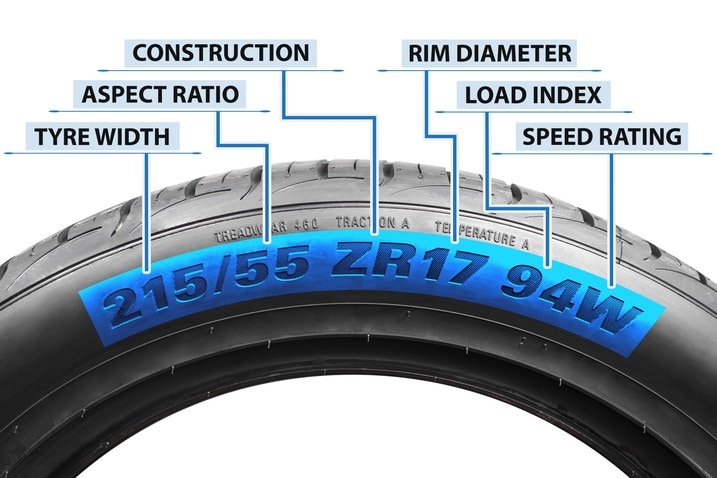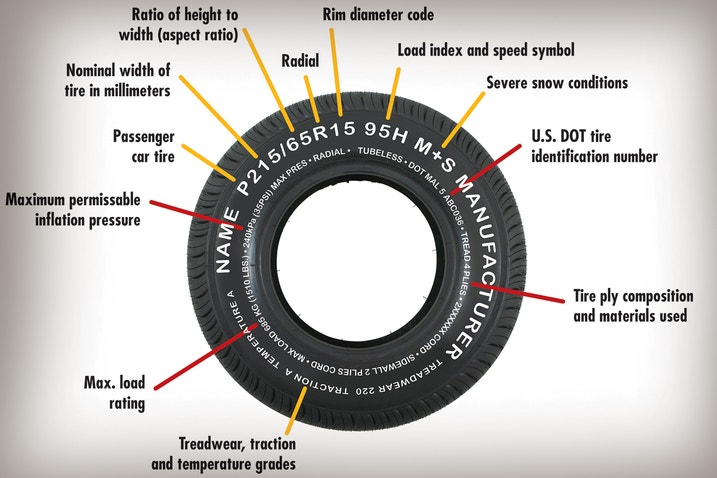The service description may not always appear on the tire, but it is important to know how it can affect your vehicle. If there is a "P" on the sidewall, it stands for "passenger car." This refers to the U.S. (P-metric) method of tire sizing. "LT" stands for light truck, "ST" stands for special trailer, and "T" stands for temporary, which is primarily used for small spare tires. If a tire does not have a P or another letter in front of the numbers, it is considered a Euro-metric tire. A Euro-metric tire conforms to European tire specifications and often carries a different load index than a comparably sized P-metric tire. We'll discuss load index in more detail below.
The first number in this series refers to the tire's section width, or the distance from sidewall edge to sidewall edge, measured in millimeters up and over the tire's tread. Generally speaking, the larger this number is, the wider the tire will be.
This number is the tire's aspect ratio, or its section height, compared to its section width. In this example, the section (or sidewall) height is 65% of the section width. This number can be indicative of a tire's purpose. Lower numbers, like 55 or less, mean a short sidewall for improved steering response and better overall handling.
The R refers to radial construction, which has been the industry standard in passenger car tires for more than 25 years. Before radial tires, most cars came with bias-ply tires, which had a crude construction that made for poor handling. Bias-ply tires (which use a "B" for their description) are still used for certain truck applications.
This is the wheel (or rim) diameter, in inches, for which the tire was sized. Consider this number if you plan on upgrading your wheel size. If your wheel diameter changes, you must purchase a new set of tires that matches this new diameter.
A tire's load index measures how much weight each tire is designed to support. The larger the number, the higher the load capacity. This is one of the most important numbers on your tire. To find out what "95" means, you have to look it up on a load index conversion chart. Ninety-five indicates a maximum weight of 1,521 pounds. Remember that this is per tire, which means you have to multiply by four to get the total capacity for a complete set of tires. If the vehicle has its original tires, you can just refer to the doorjamb, which lists the maximum cargo capacity with passengers.
Some vehicles are equipped with XL tires. It doesn't mean that they're extra large, but it does mean that they are extra-load tires. The load index on these tires is much higher than on a standard-load tire, which is why it is important to replace an XL tire with another XL tire.
Earlier, we discussed P-metric and Euro-metric sizing, and it's the difference in their load rating that can lead to confusion and potential trouble. For a given size, P-metric tires will have a load index one or two points lower than corresponding Euro-metric tires. So, if your car came with Euro-metric tires, don't replace them with P-metric tires. You can, however, replace P-metric tires with equivalent-size Euro-metric ones because you gain load capacity that way.
Why is this important? Generally speaking, you don't want your replacement tires to have a lower load index number than the originals (again, as indicated by the driver's doorjamb or the owner's manual), particularly with high-capacity vehicles that ride on smallish tires, such as minivans.
Also, optional large-diameter wheels with lower-profile tires tend to have less load-carrying capacity because they contain less air. It is the volume of air inside the tire, not the rubber itself or the wheel material, that shoulders the load. The load index is especially important when shopping for a tire online since some retailers do not specify whether a tire is P-metric.
The speed rating is a measurement of the speed at which the tire is designed to run for extended periods. An H speed rating signifies that this tire can be safely run at speeds of up to 130 mph for extended periods. Will it explode if it goes to 140? Not immediately. But it might if it is run at that speed for an extended time.
Here is a complete list of the various tire speed ratings and their associated letters:
L = 75 mph (commonly seen on off-road and light truck tires)
M = 81 mph (commonly seen on temporary spare tires)
N = 87 mph
P = 93 mph
Q = 99 mph (commonly seen on winter tires)
R = 106 mph
S = 112 mph
T = 118 mph
U = 124 mph
H = 130 mph
V = 149 mph
*Z = Over 149 mph
*W = 168 mph
*Y = 186 mph
*(Y) = Over 186 mph
*The Z rating used to be the highest rating for tires having a maximum speed capability greater than 149 mph. However, as tire technology improved, it ultimately split into the W and Y ratings. "ZR" may sometimes appear in the size designation as a nod to the prior rating, but it will also be used in conjunction with a W or a Y. When a Y rating is enclosed in parentheses, it means that the tire is capable of speeds in excess of 186 mph.
DOT code
The DOT code is used by the Department of Transportation (DOT) to track tire production for recall purposes. If a tire proves defective, this number helps track where these tires ended up so buyers can be notified of the problem. At the end of the DOT code, you'll find a four-digit number. This is the tire's manufacturing date. The first two digits stand for the week; the other two are for the year. For example, if your tire had "1621" listed, it was manufactured on the 16th week of 2021.
If you come across a three-digit number, you have a tire manufactured before 2000. A DOT tire code of "127" indicates the tire was made on the 12th week of the seventh year of the decade. But it's difficult to know whether that was 1997 or even 1987. According to Tirerack.com, some tires produced in the 1990s may have a small triangle following the DOT number to identify the decade. But any tire that has a three-digit code is history. Tire experts recommend that you replace tires that are 6 or more years old regardless of their tread depth.
Sometimes, the DOT number is located on the inside of the tire. In this case, you can either jack up the car to inspect it or check with your local mechanic or tire shop. You should also make a habit of checking the manufacturing date on your spare tire.
Maximum air pressure
This number refers to the maximum amount of air a tire can hold before it is damaged. It is not the recommended tire pressure, which can be found in your owner's manual and on the doorjamb.
Traction rating
A traction rating measures a tire's traction when testing for straight-line braking on a wet surface. It is represented in letters such as AA, A, B, or C. For this rating, AA signifies the best traction performance, and C indicates the worst.
Temperature rating
The temperature rating refers to the tire's ability to withstand heat at high speeds. The ratings, from best to worst, are A, B, and C.
Chart Source: Premiere Tires and Wheels



 by
by 


